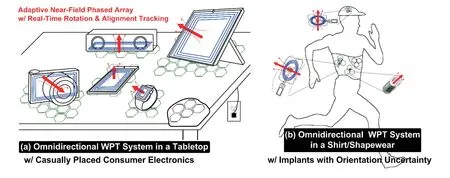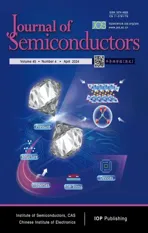Highlights in recent wireless power IC research
2024-04-23ChengHuangandJunyaoTang
Cheng Huang and Junyao Tang
Iowa State University, Ames, Iowa, 50011, USA
Wireless power transfer (WPT) has been a popular topic in power integrated circuit (IC) designs in the past decade.As slogan "cutting the last wire" presented in ISSCC’15[1], WPT is poised to take over many wired power deliveries applications today, just like what happened to wireless communication nowadays.Over the years, WPT has become more mature and more wirelessly charged or powered products have become available on the market.This mini review intends to summarize recent breakthroughs in WPT integrated circuits (IC) research.
(a) Highlights in Tx IC design
The switching power amplifier (PA) in the WPT transmitter (Tx) converts DC to AC to drive the Tx coil.There are mainly 2 types of PAs, Class D and Class E, with power efficiency and density as the most important specifications.Generally, Class D is relatively easier to control but has more power switches and limited switching node voltage swing to either VDD (half bridge) or 2× VDD (full bridge), thus is more widely used in lower power applications, while Class E is more capable to deliver a higher power capacity with more flexible LC oscillation at the switching node, thus is more suitable in higher power applications.Class E PA sometimes is supplied by a DC-DC converter to adjust its power capacity.Ref.[2]combines the buck stage and the Class E stage with a shared power inductor to reduce the cost and form-factor.The dutycycle can be adjusted to regulate the transmitted power, and a closed-loop zero-voltage switching (ZVS) control is introduced to improve efficiency.The Class E can also be reconfigured as an active rectifier for bidirectional device to device(D2D) charging.In addition, two power stages can work together differentially to provide a higher power capacity.Ref.[2] uses GaN power transistors with a higher-voltage rating for the Class-E stages, while Ref.[3] introduces an integrated solution for Tx with a new hybrid Class ED topology.By adding a controlled capacitive leg regulating to a fixed value (20 V in Ref.[3]), the Class ED topology takes advantage of both Class D (defined switching node swing for reliable integration) and Class E (continuous input current thus less noisy), with a further increase in power capacity compared to a Class E PA within a designed range of duty-cycle.It also has differential mode for higher power capacity, and ZVS control for higher power efficiency.
(b) Highlights in Rx IC design
Rx takes care of AC-DC rectification and DC voltage regulation.In the early days, a lot of efforts were put into eliminating circuit delays in the active rectifier, from fixed[4]to closedloop compensation[5], for higher voltage gain and power efficiency, and to achieve single-stage voltage regulation at Rx[6],both of which have become very matured.Providing multiple outputs, like single-inductor multiple-output (SIMO) in DC-DC converters, has become the next target as multiple rails are typically needed in an application.Ref.[7] is among the first dual-output Rx designs, combining the active rectifier stage with charge pump circuits to provide 2 regulated outputs.Ref.[8] reduced the number of power transistors from 10 of Ref.[7] to 6, by taking turns to assign the full AC power to one of the two outputs based on the needs.Then Ref.[9] further reduced the number of power transistors to 4 by dedicating each half-wave leg to one output, with hysteretic control for voltage regulation.Ref.[10] continued to implement with a different topology and adopt delay compensation at a higher switching frequency, Refs.[11, 12] introduced a time-multiplexing control with 2 and 3 outputs,respectively.
(c) Highlights in LC tank optimization
This is mostly about physics, but things can be done at the IC level, e.g., to align the LC (usually the capacitance) values to resonance.Refs.[13, 14] introduced a PWM-based tuning technique by switching capacitors in and out with a controlled duty-cycle to achieve a tuned average capacitance.
(d) Highlights in system-level WPT IC design
In addition to circuit-level innovations, system-level innovations (usually also come with circuit-level innovations) also appeared frequently in ISSCC.Most innovations are related to two focuses: wireless data + power simultaneous transmission, and three-dimensional (3D) WPT.
For forward (Tx-Rx) data + power transmission, Ref.[15]introduced a new "energy-shift keying (ESK)" technique for a higher power capacity compared to the widely used "on-off keying (OOK)" technique.The ESK works with its currentmode WPT systems that have an accumulation and an extraction phase for weak coupling.The Tx transmits "1"/"0" with larger/smaller WPT amplitudes, respectively, while the accumulation phases will be shorter/longer at the Rx.By measuring the phase duration, data can be extracted at Rx without stopping the Tx as what OOK does.To optimize WPT end-to-end efficiency, the Tx needs information from the Rx to adjust its transmitted power, thus backward (Rx-Tx) data transmission is needed to close the loop.In Ref.[16], we introduced a wireless hysteretic control to achieve both Rx local voltage regulation and Tx wireless power regulation.The Rx has an analog shunt regulator that also acts like a "comparator" to generate an "over-power" signal when it is sinking current to regulateVOtoVREF(the high boundary).The Rx then creates a short "low-impedance" period as a "load-shift keying (LSK)" signal.This impedance change then reflects to Tx and is captured by an integrated current sensor, triggering a low-power pulse-skipping mode at the Tx to reduce its transmitted power.When the RxVOreaches the lower boundary, another LSK signal will be sent to the Tx to recover it back to the fullpower mode.At light-load, the lossy LSK communication is much less frequent compared to Ref.[17] with an adaptively longer low-power mode, thus improving the efficiency by up to 20%.A fast transient response was also achieved.Ref.[18]further improved the coupling coefficient (k) range by a different LSK detection technique, from a simple "amplitude" detection in Ref.[16] that the thresholds were subject to change at differentkto "phase-shift" and "time-constant" detection for 1x-0x and 0x-1x mode conversion, respectively.Both of Refs.[16,18] require Tx to switch continuously at low-power mode to recover LSK signals.Ref.[19] introduced a smart idea to allow a non-switching Tx by introducing a phasedlock loop (PLL).There are two frequencies in this system, one is the actual switching frequency of 6.78 MHz, the other is the global 0x-1x-mode switching frequency generated at Rx.The "frequency" below refers to the latter.During the start-up process, the Tx switches continuously to detect and synchronize its frequency to the Rx generated one.Once established,the Tx then stops switching when Rx enters 0x mode.At different loading/coupling conditions, only the global duty-cycle changes while its frequency remains relatively constant.The Tx senses the Rx 1x-0x conversion (by LSK), stops switching,and then enables switching 150 ns earlier before the global 0x-1x period ends, with the 150 ns acting as a cushion period to allow frequency resynchronization.
Omnidirectional WPT is an emerging topic in WPT.Most existing WPT systems require parallel alignment between the Tx and Rx.When the Rx coil is rotated and misaligned with the Tx coil, thekwill drop significantly.This is one of the major limitations of WPT systems and the development is still in its infancy.Ref.[20] uses an actual 3D ball-shape Tx structure to transmit power from different dimensions, which is the most popular approach in the literature, however, it is very bulky.We believe that 3D WPT using only 2D structures would be more suitable for more applications, as illustrated in Fig.1.In Ref.[21], by using a controlled planer Tx coil array driven by signals with different amplitudes and phases, the magnetic fields can be shaped towards the optimum orientation, with Tx driving signal determined by off-chip controllers for higher-power applications with strong coupling.Ref.[22] introduced an "active echo" technique to determine optimum Tx driving signals on-chip by reversely projecting power from the Rx back to Tx and measure the phase and amplitude difference between the different Tx coils, extending this planer "near-field phased-array" to weakly coupled biomedical applications.These pioneer works serve as important steps towards the vision illustrated in Fig.1.

Fig.1.(Color online) 3D WPT in a 2D surface: (a) a desktop with delivering power to casually placed consumer elec-tronics; (b) a shapewear/hat delivering power to implants or capsules with orientation and position uncertainty.
In conclusion, this paper summarized innovations of WPT research mostly from ISSCC works in recent years.As shown above, WPT is a very diverse area and innovations have been introduced in different components and hierarchies.This will surely continue, and more efforts will be needed to make WPT systems more capable, powerful, and efficient, to really"cut the last wire" for more applications.
杂志排行
Journal of Semiconductors的其它文章
- Chemical vapor deposition for perovskite solar cells and modules
- Recent advancements in continuously scalable conversion-ratio switched-capacitor converter
- Towards efficient generative AI and beyond-AI computing:New trends on ISSCC 2024 machine learning accelerators
- Millimeter-wave PA design techniques in ISSCC 2024
- Light-emitting devices based on atomically thin MoSe2
- Anomalous bond lengthening in compressed magnetic doped semiconductor Ba(Zn0.95Mn0.05)2As2
